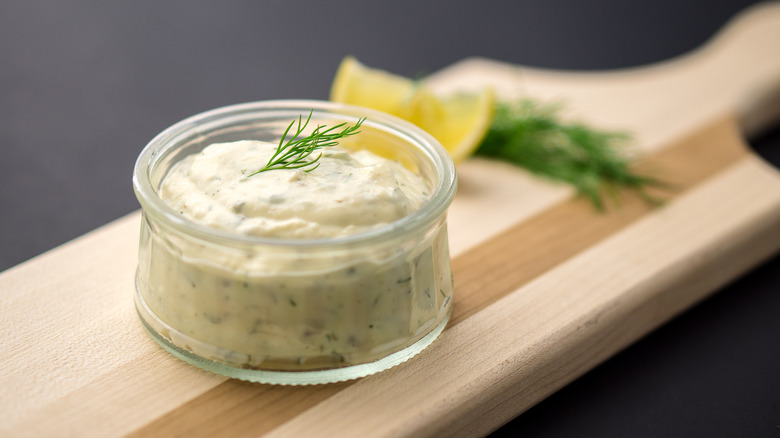Tartar Sauce Was Always Made From Scratch Until This Brand Stepped In
Every time you're preparing seafood, especially crispy fried calamari or crunch-coated fried shrimp, there's a good chance that you reach for tartar sauce in all of its creamy, tangy, acidic, briny, sweet, herbaceous glory. The easiest way to serve it up, especially when your attention is on cooking the fish to perfection, is to grab a jar of it off the shelf at your regular grocery store. That's been an option for a century or so — before that, tartar sauce was an exclusively homemade condiment. According to a report by Sporked, it's believed Hellmann's changed that by selling the first jarred offering in the 1920s.
It's no surprise that Hellmann's was likely the brand to make a popular sauce all the more convenient by prepping it, jarring it, and selling it at stores. Hellmann's mayonnaise has long been an American favorite, and mayonnaise is an essential part of tartar sauce. The brand started as a deli in New York City in 1920. Richard Hellmann made his own mayonnaise, which went on to fill shelves at more and more stores across the country throughout the 1920s and beyond; apparently, he was also busy expanding his portfolio with the tartar sauce as well as other products like salad dressings. The plot twist? In 2024, Hellmann's discontinued its tartar sauce. So the brand that started it all no longer participates in the store-bought tartar sauce game, which is now populated by brands like McCormick, Colman's, and Kraft, which we ranked in our list of worst-to-best tartar sauces.
Murky origins and the tradition of making tartar sauce from scratch
In general, tartar sauce's entire origin story is a bit hazy. Many countries have thrown their hats into the ring of tartar sauce invention claims, but France has the strongest case. The first written mentions of the condiment can be found in 19th-century French cookbooks, after all. It seems that while we can't imagine fried fish without tartar sauce, French diners in the 1800s paired it with beef tartare, which helps explain its name. Further establishing the connection behind that moniker is the fact that there was a group of people in Western Russia and Turkey known as Tatars who ate their meat shredded. This could be related to the French tartare preparation, and then the sauce they whipped up to go with it by extension.
This loose history and the different dishes cultures call on this condiment for are just some of the key facts to know about tartar sauce, but perhaps the most important of all is how exactly it's made. If you were craving the sauce pre-Hellmann's in the 1920s, you would have had to make it yourself. Mayo is the base, and chopped pickles or relish is also crucial, giving you that creaminess, tang, acidity, and brine. Expect the bright zest of lemon, as well as other spicy flavors from Dijon mustard, garlic, and capers. While Hellmann's made store-bought tartar sauce an effortless reality, it's pretty easy to toss these tasty ingredients together at home too.

